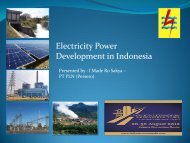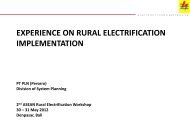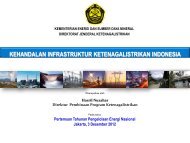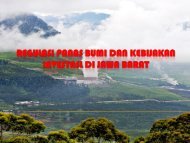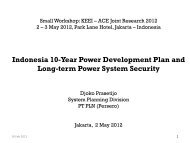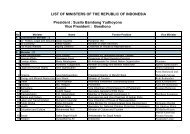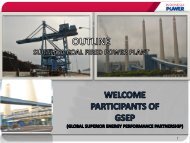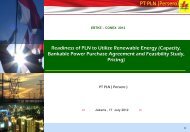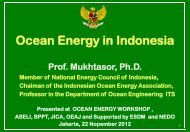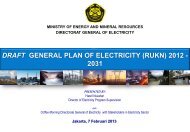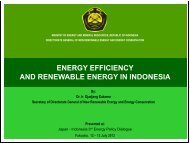INDONESIA'S LOW CARBON ENERGY DEVELOPMENT
INDONESIA'S LOW CARBON ENERGY DEVELOPMENT
INDONESIA'S LOW CARBON ENERGY DEVELOPMENT
Create successful ePaper yourself
Turn your PDF publications into a flip-book with our unique Google optimized e-Paper software.
Ministry of Energy and Mineral ResourcesDIRECTORATE GENERAL OF NEW RENEWABLE <strong>ENERGY</strong> AND <strong>ENERGY</strong> CONSERVATIONMINISTRY OF <strong>ENERGY</strong> AND MINERAL RESOURCESINDONESIA’S<strong>LOW</strong> <strong>CARBON</strong> <strong>ENERGY</strong> <strong>DEVELOPMENT</strong>By:Kardaya WarnikaDirector General for New, Renewable Energy and Energy ConservationWorkshop on Bilateral Offset Credit MechanismTokyo, 17 th November 2011
Ministry of Energy and Mineral ResourcesNational Energy Mix 20101.066 millon BOEGeothermal1.5%Coal26.38%Gas21.9%Hydro3.29%I. CURRENT <strong>ENERGY</strong> CONDITIONOil46.93%Energy Elasticity = 1,60Non Fossil Energy Share < 5%1. People access to energy is still limited :a. Electrification ratio in 2010 is 67,2% (32,8% ofhousehold is not yet have access to electricity);(Appendix 1)b. Development of the infrastructure (rural area andouter island commonly is not yet have access toenergy);2. Energy consumption growth is 7% per year, not yetbalance with the energy suppy; (Appendix 2)3. The depence to fossil energy is high, besides theenergy reserve is limited; (Appendix 3)4. Fossil subsidy is increasing; (Appendix 4)5. Renewable energy utilization and energyconservation implementation is not yet optimized;6. Link with environmental issue:a. Climate change mitigation;b. Clean energy initiative: national commitment toreduce emission by 26% in 2020;7. Funding for energy development is limited1
Ministry of Energy and Mineral ResourcesVision :•Energy Security with the optimum energy conservation and diversification measuresMission :II. INDONESIA <strong>ENERGY</strong> POLICY•Achieve the National Energy Policy target of energy elasticity less than 1 and share ofnew renewable energy as much as 17% in total primary energy supply by 2025•Commit to maximize the implementation of energy conservation for household,commercial, industry, and transportation sector in amount of 33,85% and achieveshare of new renewable energy in amount of 25% by 2025. (Appendix 5)Policy Direction•President’s commitment at G-20 Forum Pittsburgh, USA (2009) to reduce emission by26% in 2020 and up to 41% with the international support. (Appendix 6)•Policy Directives at Bali Retreat (2010) to achieve energy security and GreenEconomy. (Appendix 7)•Need to reframe the low carbon energy industry.2
Ministry of Energy and Mineral ResourcesIII. CLEAN <strong>ENERGY</strong> INITIATIVE:Reducing Emissions from Fossil Fuel Burning (REFF-Burn)A. Pre-Fossil Combustion to avoid using more fossil energy :1. Efficient Energy Technologies (High Efficiency Light, Efficient Appliances, etc)2. Renewable Energy Technologies (Geothermal, Hydro, Solar, Wind, etc)3. Fossil Pre-Treatment (Coal Upgrading)B. During Fossil Combustion to reduce greenhouse gases emitted from fossil fuel burning:1. Efficient Technologies (Co-generation)2. Low Carbon Electricity Generation (High Efficiency Low Emission, IGCC, etc)3. Clean Fuel Technology (Fuel Switching)C. Post Fossil Combustion to capture and store the greenhouse gases from fossil fuel burning :1. Carbon Capture and Storage Technologies (CCS & Algae)2. Utilization of CO23
Ministry of Energy and Mineral ResourcesIII. REFF-Burn... (cont.)3.1 POLICY AND STRATEGY FRAMEWORK• Energy efficiency improvement (Energy Conservation)• Renewable energy maximization (Energy Diversification) Fuel based renewable energy development Electricity based renewable energy development (Appendix 8)• Low Carbon Fossil Technology Implementation3.2 POLICY INSTRUMENTS (1)Legal• Law No. 10/1997 on Nuclear Power• Law No. 27/2003 on Geothermal.• Law No. 7/2004 on Water Resources.• Law No. 17/2007 on National Long Term Development Plan.• Law No. 30/2007 tentang Energy• Law No. 30/2009 tentang Electricity4
Ministry of Energy and Mineral ResourcesIII. REFF-Burn... (cont.)3.2 POLICY INSTRUMENTS (2)Fiscal• Fiscal incentive for NRE development (Article 20 paragraph 5 Law No. 30/2007)• Pricing for new renewable energy (Feed-in Tariff/FIT)• Renewable Portfolio Standard (RPS)Institutional• National Energy Council• Ministry of Energy and Mineral Resources (National Level)• Governor, District Mayors (Local Level)Funds• National budget (APBN, APBD, Private Budget) and International budget frompartners• Clean Development Mechanism (CDM)5
Ministry of Energy and Mineral ResourcesIV. GEOTHERMAL <strong>DEVELOPMENT</strong> IN INDONESIAPotential: Host 40% of total world’s geothermal potential, Al Gore said that Indonesia is likely tobe a ‘geothermal superpower’ in the future (Appendix 9, 10) Optimum utilization will significantly reduce dependence on fossil fuel, reduce GHGemission and improve national energy security Geothermal utilization would reduce energy subsidy by avoided oil consumption(Appendix 11)Restructuring Geothermal Business to allow private participation in geothermaldevelopment (Appendix 12)Barriers: Higher price compared to the least-cost-options (e.g. coal power plant) High upfront risk in exploration stage:Reflected in higher energy cost lowering competitiveness to the least-cost-optionsBig owner-investment needed, limiting the playing field Land-use issues e.g. situated in protected forest, cultural site, water availability, etc.6
Ministry of Energy and Mineral ResourcesAdopted Measures: (Appendix 13)IV. GEOTHERMAL <strong>DEVELOPMENT</strong> IN INDONESIA (contd)Various policies and incentives including tariff scheme, fiscal incentives, tenderincentives, land policy, etcGovernment guarantee, provided by Ministry of Finance’s Decree, to mitigateinvestment risksEncourage developers to take carbon revenue, i.e. CERsPlan to deploy IDR 1.2 T as revolving fund to support exploration stage in easternIndonesiaRecent Updates: (Appendix 14) 5 new GWAs with potential of 703 MW was determined on 4 April 20111 GWA is in the auction process7 new GWAs with total potential of 879 MW are going to be tendered in nearfuture.7
Ministry of Energy and Mineral ResourcesV. GEOTHERMAL IN INDONESIAN CLIMATE CHANGE• According to Indonesia GHG Abatement Cost Curve 2010, Geothermal provide apotential to reduce emission ± 40 MtCO2 per year in 2030 with the net positiveabatement cost of USD 27/tCO2e. (Appendix 15, 16)• Geothermal power plant is not included in the energy sector emission reductioncommitment (30 mtCO2e), thus making it available for market mechanism.• Currently, there are 9 (nine) geothermal projects in the carbon market pipelines.(Appendix 17)• The average days needed for Geothermal Projects to be registered as CDMProjects are ± 250 days, higher than average CDM registration process inIndonesia of 150 days.• Main problems of registering geothermal projects as CDM projects is additionalissues (barrier analysis, investment analysis using benchmark). (Appendix 18)8
Ministry of Energy and Mineral ResourcesCONCLUSION• Indonesia is actively participating in mitigating GHG emission to combat globalwarming. The national GHGs emission will rise in line with the nationaldevelopment, particularly from energy sector.• The GHGs mitigation in energy sector poses an opportunity as well as challenge toimplement clean energy that focuses on new renewable energy development,implementing efficiency energy and clean energy technology.• The Clean Energy Initiative is an integrated effort of the energy sector to fulfill thenational security energy supply and mitigate the global GHGs emission.• Whilst some supporting policies are in place, acceleration of geothermaldevelopment in Indonesia is still needed and possible, such as through support ofGHG mitigation mechanism.9
Ministry of Energy and Mineral ResourcesThank YouGo Green Indonesia !Green energy, Future energyKEMENTERIAN ENERGI DAN SUMBER DAYA MINERAL REPUBLIK INDONESIADIREKTORAT JENDERAL ENERGI BARU, TERBARUKAN, DAN KONSERVASI ENERGIJalan Jenderal Gatot Subroto, Kav. 49 Jakarta 12950; Phone/Fax : 021-5250575www.ebtke.esdm.go.id www.energiterbarukan.net www.konservasienergi.net10
Ministry of Energy and Mineral ResourcesAppendices11
Ministry of Energy and Mineral ResourcesNAD90,85%Sumut79,05%Sumbar71,13%Jambi75,71%Bengkulu61,11%Lampung61,25%Riau58,66%Banten67,29%Sumsel56,39%Jabar69,04%CURRENT CONDITION OF ELECTRICITY(Electricity Ratio)Kepri44,45%Kalbar58,34%Babel68,73%Jakarta100%Jateng70,42%Kalteng57,07%Kalsel70,53%DIY75,70% Jatim65,54%Kaltim65,25%Sulbar60,85%Bali70,87%NTB31,20%Gorontalo46,79%YearSulteng56,04%Sulsel65,93%Sultra47,11%Sulut65,84%NTT29,10%Malut63,84%Maluku72,62%Category :Papua31,61%Appendix 1> 60 %41 - 60 %20 - 40 %Papua Barat41,87%ElectricityRatio1980 1985 1990 2000 2005 2006 2007 2008 2009 20108% 16% 28% 53% 62% 63% 64.34% 65.10% 65.79% 67.15%12
Ministry of Energy and Mineral ResourcesDEMAND(Million BOE)GROWTH OF <strong>ENERGY</strong> SUPPLY AND CONSUMPTION1990 - 2010350,9508,9594,6739,5Appendix 2Household11,4 %Commercial3,7%Transportation40,6%18,5%2,5%30,7%48,2%248,0Industry44,2%56,6 %4,6%34,2 %4,5 %525,4Oil46,93%`Coal26,4%SUPPLY(Million BOE)700,4 726,7896,41066,0Gas21,9 %NRE4,8 %1990 1991 1992 1993 1994 1995 1996 1997 1998 1999 2000 2001 2002 2003 2004 2005 2006 2007 2008 2009 201013
Ministry of Energy and Mineral Resources<strong>ENERGY</strong> RESERVES AND PRODUCTIONAppendix 3NONON FOSSIL <strong>ENERGY</strong>RESOURCES(SD)INSTALLEDCAPACITY (KT)RATIO KT/SD(%)1 2 3 4 5 = 4/31 Hydro 75,670 MW 5,705.29 MW 7.542 Geothermal 29,038 MW 1,189 MW 4.103 Mini/Micro Hydro 1,013.5 MW 462.0 MW 46.04 Biomass 49,810 MW 1,618.40 MW 3.255 Solar Energy 4.80 kWh/m 2 /day 13.5 MW -6 Wind Energy 3 – 6 m/s 1.87 MW -7 Uranium3.000 MW(e.q. 24,112 ton) for 11 years *)30 MW(Thermal)1.00*) only in Kalan – West KalimantanNOFOSSIL <strong>ENERGY</strong>RESOURCES(SD)RESERVES(CAD)RATIOSD/CAD(%)PRODUCTION(PROD)RASIOCAD/PROD(YEAR)*)1 2 3 4 5 = 4/3 6 7 = 4/61 Oil (billion barrel) 56.6 7.99 **) 14 0.346 232 Gas (TSCF) 334.5 159.64 51 2.9 553 Coal (billion ton) 104.8 20.98 18 0.254 834 Coal Bed Methane/CBM (TSCF) 453 - - - -*) Assuming no new discoveries**) Cepu Block is included14
Ministry of Energy and Mineral ResourcesGROWTH OF SHARE AND FOSSIL SUBSIDY 2000 – 2009Appendix 41065 NRE10144,07%A. Growth of Total Share (inmillion BOE)956859873 89689718,48 %800772Natural Gas727The last 10 years average growth:1. Oil : 0,52 %/year2. Coal : 13,70 %/year3. Natural Gas : 1,81 %/year4. Total : 4,33 %/year34,47 %Coal42,99 %OilB. Growth of Fossil Subsidy (in trillion Rupiah)2000 2001 2002 2003 2004 2005 2006 2007 2008 20091. Electricity Subsidy 3,93 4,30 4,10 3,36 3,31 10,65 33,90 37,48 78,58 53,722. Fossil ElectricitySubsidy *)3.30 3.55 3.49 2.92 2.86 9.20 29.75 32.63 68.16 46.143. Fuel Subsidy 55.64 63.26 31.75 30.04 59.18 103.35 64.21 83.79 139.03 45.044. LPG Subsidy 0 0 0 0 0 0 0 0.15 3.84 7.78Total Fossil Subsidy58.94 66.81 35.24 32.96 62.04 112.55 93.96 116.57 211.03 98.96*) Proportionate to the role of fossils in the composition of primary energy for electricity supply15
Ministry of Energy and Mineral ResourcesPOLICY DIRECTIONAppendix 5BAU**PERPRES 5/2006 VISION 25/254300Million BOE3,1%34.6%3200Million BOE2852Million BOE<strong>ENERGY</strong>CONSERVATION(33,85%)NRECoalGasOil1066MillionBOE4,4 %30,7 %21 %43,9%20,6%41.7%17%33%30%20%25 %NRE22 %Coal23 %Gas30 %Oil<strong>ENERGY</strong>DIVERSIFICATION2010* 2015 2020Source: *Estimation 2010, DEN 2010-2025, **BAU EBTKE202516
Ministry of Energy and Mineral ResourcesAppendix 6NATIONAL COMMITMENT TO REDUCE GHG EMISSIONPresidential Regulation No. 61 Year 2011 onNational Action Plan on GHG Emission ReductionOwnefforts26%(767 mln Ton)41%Own efforts andinternationalsupportForestry, Peat Land,AgricultureEnergy SectorWaste680 million Ton30 million Ton48 million TonThrough the developmentof new renewable energyand implementing energyconservation by all sectorsIndustry andTransportation9 million Ton17
Ministry of Energy and Mineral ResourcesAppendix 7<strong>DEVELOPMENT</strong> OF <strong>LOW</strong> <strong>CARBON</strong> <strong>ENERGY</strong>UU 10/1997UU 27/2003UU 30/2007UU 30/2009UNFCCC *)Climate ChangeMitigationPolicy DirectivesPresident RIin Tampak Siring(2010)No.8 : Energy SecurityNo.10 : Strengthen theGreen EconomyGreenValuesIncreasingConsumption ofFossil EnergyGREEN <strong>ENERGY</strong> CONCEPT:1.Efficient energy utilization2.Renewable energy use3.Use Clean Energy Technologies forfossil and non-fossil energyThe effort of new andrenewable energydevelopment, andEfficient EnergyUtilizationGreen Energy0Green IndustryGreen Transportation*) United Nations Framework Convention on Climate ChangeEnergy Security,Social Welfare,SustainableDevelopment18
Ministry of Energy and Mineral ResourcesPATTERNS OF <strong>ENERGY</strong> BUSINESS AND COMMERCIAL SCHEMESFOR NEW AND RENEWABLE <strong>ENERGY</strong>Appendix 8FUEL BASEDINDEPENDENT FUEL PRODUCERS (IFP)FUEL BUSINESS AREANationalBusinessAreaNREPILOT PROJECTELECTRICITYBASEDINDEPENDENT POWER PRODUCERS (IPP)MINI GRIDOFF GRID/ PILOT PROJECTNationalBusinessAreaPola 1 : INDEPENDENT PRODUCERS• Fuel based : Independent Fuels Producers:NRE enterprises (liquid, gas, or solid) supply the NRE to the enterprise which has business license, such as PT Pertamina (Persero)• Electricity based :Independent Power Producers :NRE enterprises produce electricity and sell it to the PT PLN (Persero)Pola 2 : MINI PRODUCERS/MINI GRID• Fuel based: Limited Business AreaNRE enterprises sell NRE product and distribute it to the limited business area.• Electricity based : Mini Grid:NRE enterprises produce electricity from NRE and distribute it with decentralized way.Pola 3 : PILOT PROJECTGovernement/Local Government/Business build NRE Conversion Installation and Submit / Assets donated to the Business Entity (with license).19
Ministry of Energy and Mineral ResourcesGEOTHERMAL POTENTIAL IN INDONESIAAppendix 9NEXTPLTP SIBAYAK: 12 MWPertamina Geothermal Energy1,6 cents$/KwhPLTP LAHENDONG: 60 MWPertamina Geothermal Energy5,25 cents$/KwhPLTP WAYANG WINDU: 227 MWStar Energy Geothermal WW Ltd.5,6 cents$/KwhPLTP GUNUNG SALAK: 375 MWChevron G. Salak Ltd.6,6 cents$/KwhPLTP KAMOJANG: 200 MWPertamina Geothermal Energy4,4 cents$/KwhNo.PLTP DARAJAT: 255 MWChevron Geothermal Indonesia5,76 cents$/KwhIslandNumber ofLocationsPotency(MW)PLTP DIENG: 60 MWGeoDipa4,94 cents$/KwhInstalledCapacity(MW)1 Sumatera 86 13.516 122 Java 71 10.092 1.1173 Bali 5 2964 Nusa Tenggara 22 1.4715 Kalimantan 8 1156 Sulawesi 55 2.519 607 Maluku 26 9548 PapuaTotal32767529.038 1.189Source : Geological Survey, MEMR(2010)Note:Preliminary SurveyReady to DevelopadDetail SurveyAlready Developed20
Ministry of Energy and Mineral ResourcesNAD 2 GWAJaboi: 70 MWSeulawah Agam: 130 MW50 GEOTHERMAL WORKING AREAThe GoI has issued 31 new Geothermal Working Areas (GWA or Wilayah Kerja Panasbumi).Up to 50 further geothermal working areas are expected to be offered at a later date.Appendix 10SUMUT 4 GWASibayak – Sinabung: 130 MWSibual – Buali: 750 MWSipaholon Ria-ria: 75 MWSorik Marapi: 200 MWJAMBI 1 GWASungai Penuh: 70 MWSUMSEL 3 GWALumut Balai: 250 MWRantau Dedap: 106 MWDanau Ranau: 210 MWGORONTALO 1 GWASuwawa: 110 MWSULUT 2 GWAKotamobagu: 410 MWLahendong-Tompaso: 358 MWMALUT 2 GWAJailolo: 75 MWSonga Wayaua: 140 MWSUMBAR 4 GWABukit Kili: 83 MWGn Talang: 35 MWLiki Pinangawan: 400 MWBonjol: 200 MWBENGKULU 1 GWATmbg Sawah-Hululais: 873 MWBANTEN 2 GWAKaldera Danau Banten: 115 MWG. Endut: 80 MWBALI 1 GWATabanan: 276 MWSULTENG 1 GWAMarana: 35 MWLAMPUNG 3GWAGn.Rajabasa: 91 MWSuoh Sekincau: 230 MWWaypanas – Ulubelu: 556 MWDanau Ranau: 210 MWJABAR 10 GWACiater - Tgkban Perahu: 60 MWCibeureum–Parabakti: 485 MWCibuni: 140 MWCisolok Cisukarame: 45 MWGn. Tampomas: 50 MWGn. Tgkuban Perahu: 100 MWKamojang-Darajat: 1465 MWKaraha Cakrabuana: 725 MWPangalengan: 1106 MWG. Ciremai: 150 MWJATENG 4 GWABaturaden: 175 MWDataran Tinggi Dieng: 780 MWGuci: 79 MWGn. Ungaran: 100 MWJATIM 3 GWABlawan – Ijen: 270 MWGn. Iyang Argopuro: 295 MWTelaga Ngebel: 120 MWNTB 1 GWAHu'u Daha: 65 MWNTT 4 GWAAtadei: 40 MWSokoria: 30 MWUlumbu: 199 MWMataloko: 63 MWMALUKU 1 GWATulehu: 100 MW21
Ministry of Energy and Mineral ResourcesSUBSIDY SAVING ON ELECTRICITYFROM GEOTHERMAL POWER GENERATIONAppendix 11⊄ US$MALUTJAMALI GridNTT GridSUMBAGUTSUMBAGSEL-BARAT-RIAU25.7 ⊄26.9 ⊄ 26.9 ⊄TM19.1 ⊄TT20.9 ⊄23.9 ⊄18.9 ⊄BPP (productioncost) per kWhLocal PLN GridSystemGeothermal(PLTP) PriceTender Resultper kWhSubsidy12.9 ⊄AvoidedElectricitySubsidy9.7 ⊄Ceiling Price6.9 ⊄8,7 ⊄5,9 5.9 ⊄Currnet average of PLN’s BPP8,7 ⊄8,7 ⊄ 8,7 ⊄ 8.09 ⊄7.0 ⊄6.6 ⊄9.5 ⊄13.8 ⊄8.1 ⊄9.5 ⊄6.3 ⊄9.4 ⊄6.9 ⊄6.3 ⊄ 6.3 ⊄Currentaverage TDL22
Ministry of Energy and Mineral ResourcesAppendix 12GEOTHERMAL BUSSINESS STRUCTUREPreviously, all Geothermal Working Areas (GWA) are exclusively managed by National OilCompany (PERTAMINA). Now GWA can be managed by private entities.PREVIOUS BUSSINESSSTRUCTURECURRENT BUSSINESSSTRUCTUREGeothermalWorking AreaJoint OperationContractORExploration/ExploitationRight Granted ThroughTender ProcessGeothermalWorking AreaPERTAMINAThird PartyThird PartyEnergy Sales Contract(Steam or Electricity)Energy Sales Contract(Electricity)PT. PLN (Persero)PT. PLN (Persero)23
Ministry of Energy and Mineral ResourcesGOVERNMENT POLICIES TO SCALE UPGEOTHERMAL <strong>DEVELOPMENT</strong> IN INDONESIAAppendix 13NEXTThe Government of Indonesia (GoI) intends to accelerate and speed up the development ofgeothermal. In order to do so, the government intends to enhance the investment climate for bothexisting developers as well as new entrants to the geothermal sector in Indonesia.Government Policies:1.Presidential Regulation No. 04/2010 jo Ministerial Regulation No. 15/2010 (2 nd Stage of 10,000MW Crash Program) in order to speed up the development of geothermal power to the amount of3,967 MW by the year 2014 which will require a total of US$ 12 Billions.2.Pricing Policy•Ministrial Regulation of MEMR No. 02/2011 on geothermal price structure. The MR gives certaintyon electricity price from geothermal power plant:- Electricity price as the result of a GWA tender, is represent as purchase price by PT PLNin the Power Purchase Agreement, which is final and non negotiable- Ceiling price for geothermal energy: US$ 9.7 cents/kWh- If the price exceeds US$ 9.7 cents/kWh, negotiations between Parties are needed.24
Ministry of Energy and Mineral ResourcesAppendix 13GOVERNMENT POLICIES TO SCALE UPGEOTHERMAL <strong>DEVELOPMENT</strong> IN INDONESIA (contd)NEXT• Fiscal incentives for geothermal development (based on Government Regulation No. 62/2008jo No. 1/2007; MR of MoF No. 139/PMK.011/2011; and MR of MoF No. 22/PMK.011/2011) :- 30% of corporate income tax;- 10% of added-value tax paid by the GoI;- Custom duties exemption for geothermal developer;- 25% per year depreciation for 8 years with double declining balance method; and- Investment tax credit 5% per year for 6 years.• Currently the mechanism of Feed in Tariff for each GWA is being developed by the GoI inorder to make geothermal business more attractive to investors.• Government policies in order to mitigate risks that may exist :- The GoI will establish state-owned enterprise for conducting the exploration activities such asexploration drilling.- The Government will provide revolving funds (for exploration and feasibility study), particularlyfor the Eastern parts of Indonesia.25
Ministry of Energy and Mineral ResourcesAppendix 13GOVERNMENT POLICIES TO SCALE UPGEOTHERMAL <strong>DEVELOPMENT</strong> IN INDONESIA (contd)NEXT• The GoI c.q. MEMR have been received grant from Global Environment Facility (GEF)through the WB to review existing regulation and to develop new policy and mechanism inpricing and transaction.3. Access to Potential Geothermal Resources for Investors• The Government offers a Preliminary Survey Assignment to third party (investor) whichprovides “first right refusal”.• The GoI establishes new GWAs and widely open opportunities for investors to participate inthe geothermal business through GWAs tendering mechanism• The GoI is reviewing an opportunity for offering Geothermal Areas in a single block consist ofseveral small potential Geothermal Working Area.• In order to accelerate the tender process of new GWAs, the policies which regulate biddingprocess are being revised in order to make the tender more simple, transparent andbankable• Coordinating with all relevant parties to accelerate and simplify the permit process• The GoI c.q. MEMR have been received grant from Global Environment Facility (GEF)through the WB in preparing geothermal transactions that will be offered to investors througha competitive tender process.26
Ministry of Energy and Mineral ResourcesAppendix 13GOVERNMENT POLICIES TO SCALE UPGEOTHERMAL <strong>DEVELOPMENT</strong> IN INDONESIA (contd)4. Capacity BuildingGeothermal development in Indonesia requires qualified human resources. To support crashprogram of 10.000 MW electricity developments will require at least 800.000 worker withparticular skill and knowledge on geothermal. These workers will need to be managedcapably and efficiently to meet the qualification requirements in the geothermal field.• The GoI are improving the ability, competency and professionalism human resources throughtraining, short courses and advanced level education in collaboration with local andinternational educational institutions.• The GoI c.q. MEMR have been received grant from Global Environment Facility (GEF)through the WB to build capacity among government officials, PLN and other relevant officialsfor preparing and tendering transactions, evaluating bids, and negotiating PPAs.27
Ministry of Energy and Mineral ResourcesAppendix 14RECENT UPDATES ON GEOTHERMAL WORKING AREASI. GWA list in the auction processNo.GWAPossible Reserve(MW)Dev. Plan(MW)Price (kWh) Status IUP Holder1 SEULAWAH AGAM, NAD 160 55 - Auction Process -TOTAL 160II. GWA list in preparation for auctionNo.GWAPossible Reserve(MW)1 GUNUNG TALANG, SUMBAR 36 - -2 SONGA WAYAUA, MALUT 140 - -3 BONJOL, SUMBAR 200 - -4 DANAU RANAU, LAMPUNG & SUMSEL 210 - -5 MATALOKO, NTT 63 - -6 GN. ENDUT, BANTEN 80 - -7 GN. CIREMAI, JABAR 150 - -TOTAL 879Dev. Plan Price (kWh) Status IUP HolderPreparation forAuctionPreparation forAuctionPreparation forAuctionPreparation forAuctionPreparation forAuctionPreparation forAuctionPreparation forAuction-------28
Ministry of Energy and Mineral ResourcesINDONESIA <strong>CARBON</strong> ABATEMENT POTENTIALAppendix 15NEXT29
Ministry of Energy and Mineral ResourcesEMISSION REDUCTION POTENTIAL FROMGEOTHERMAL <strong>DEVELOPMENT</strong>Appendix 1530
Ministry of Energy and Mineral ResourcesAppendix 16GEOTHERMAL PROJECTS IN <strong>CARBON</strong> MARKET• Registered in CDM EB :– Darajat Unit III Geothermal Project 110 MW (CER issued)– Lahendong II-20 MW Geothermal Project– Kamojang Geothermal 60 MW– Wayang Windu Phase 2 Geothermal Power Project 117 MW• In validation Process of CDM– Sibayak Geothermal Power Plant 11,3 MW– Project Ulubelu Unit 3-4 PT. Pertamina Geothermal Energy 110 MW– Project Lumut Balai Unit 1-2 PT. Pertamina Geothermal Energy 110 MW• Registered in Voluntary Carbon Standard– Wayang Windu Phase 2 Geothermal Power Project 117 MW (pre-CDM only)– Capacity Upgrade of Gunung Salak Geothermal Power Plant Project, Indonesia31
Ministry of Energy and Mineral ResourcesAppendix 17ADDITIONAL BARRIERS OF GEOTHERMAL PROJECTS IN CDMNoProject Name1 Darajat Unit III 110MW2 Lahendong II-20MWDemonstrationof Additionality3 Kamojang 60 MW InvestmentAnalysis usingBenchmark4 Wayang WinduPhase-2 117 MWRemarksRequest ReviewItemsBarrier Analysis - -Barrier Analysis - -InvestmentAnalysis usingBenchmarkIRR w/ CDM: 19.87%IRR w/o CDM: 16.04%Benchmark: 18.15%IRR w/ CDM: 20.48%IRR w/o CDM: 17.62%Benchmark: 18.96%Values to conductinvestment analysis;clarification of barrierand commonpractice analysisValues to conductinvestment analysis;clarification of barrierand commonpractice analysis32



